Chapter 2: The economy and war, featuring the Zulu
We start by letting the game run itself for a month. We'll get accurate data, that way. Prussia declares war on Denmark right on time, the same way they do every game. Poor Danes.
Economics
Let's look at the budget screen now.
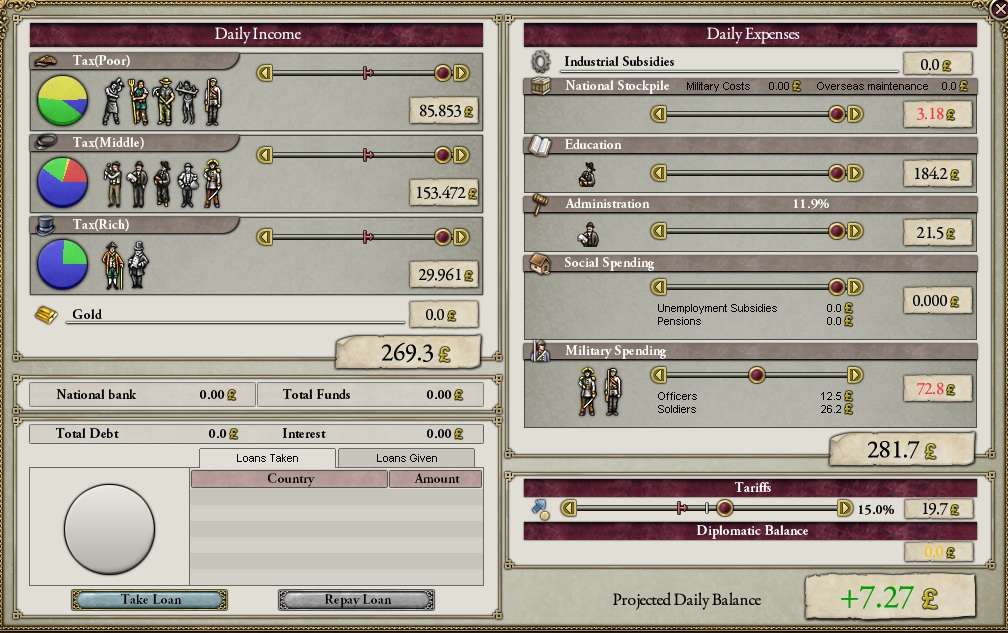 Making money is fun!
Making money is fun!
Now, although I try to avoid gamey tactics, I'll tell you one right now: until you take a certain reform, primitive nations can't go into debt. Therefore, I technically don't
need a positive balance. I've done my best to avoid the temptation in this AAR (except for a couple of times when I just wasn't paying attention). If you're the unscrupulous type, though, it's not a bad way to go.
What do we need to note on this screen? First should probably be the pies on the left hand side of the screen. These tell you, at a glance, how your people are doing. Red means they aren't getting any of their life needs; yellow means they're getting some. Green means they're getting all their life needs. Dark blue is all the everyday needs, with light blue being luxury needs. You can hover over a slice of pie for more information, including which people are suffering the worst.
I've got the budget fixed to give me a positive balance now, so some of you might say, "Hey, Avinidian! You're an idiot! If you take 100% of everybody's money in taxes, they'll go broke!" The actual tax rate is quite a bit lower, and is affected by technologies. I'm actually only getting 20%. That means the POPs only pay 20%, not that I still take all of their money and 80% is set on fire. For the moment, even with high taxes, only the middle class is suffering, and the portions that's suffering worst are the artisans.
Speaking of classes, you have three different tax rates in AHD: Poor (for Craftsmen, Farmers, Laborers, and Soldiers), Middle (Artisans, Bureaucrats, Clergy, Clerks, and Officers), and Rich (Aristocrats and Capitalists). One way to affect promotion or demotion rates -- although it's kind of cruel -- is to jack up taxes on one particular class so high they starve and have to change jobs.
Below our pies and tax rates is debt information; we'll cover that later, since we can't go into debt. On the right hand side, the large box contains five key sliders that we do need to discuss.
National Stockpile: The national stockpile is used to pay military costs and overseas maintenance; the former is the largest part. Adjusting the slider will affect the amount of supplies your soldiers get; that in turn affects organization. In fact, for EU3 veterans, it's most similar to the army and navy maintenance sliders. In peace time, you can cut this a bit, but remember that costs will always go up if you go to war.
Education: This pays your clergy.
Administration: This covers two important costs; bureaucrat salary and
country administrative efficiency (the number in white). Administrative efficiency affects tariffs, which we'll get to in a bit, and crime fighting. Crime fighting affects how much of an RGO's income actually goes into the POP's pockets (and thereby yours). It's calculated based on how well you fund administration and the
state's administrative efficiency. Techs can make your bureaucrats more efficient. Another slider you'll probably keep at maximum. (Those of you worried about the excessive bureaucrat bloat experienced in later versions of vanilla will find the problem has been handled.)
Social Spending: Administrative efficiency affects this too; the more efficient you are at distributing aid, the less you have to pay. It'll be zero until we pass social reforms; we'll talk about those when the time is right.
Military Spending: This pays your soldiers and officers, and encourages or discourages POPs to become officers and soldiers. Practically, it affects both the rate at which you get leadership and how many total brigades you can raise. Adjusting this slider will
not affect combat performance, but it could reduce the number of POPs who could replenish your troops.
In general, you want to leave Education and Administration as high as you can. National Stockpile can be played with, as can Military Spending. Social Spending can also be critical, but only if you enact the reforms that require it.
There's one more slider we need to talk about: Tariffs. If you learn nothing else from this tutorial, learn this:
Tariffs are much, much worse than taxes for long term revenue. This will take a slight digression, but only a slight one.
Taxes are imposed on your entire country more or less evenly, depending on tax rates. It's taken out when they earn money. Your effective tax rate, even with all the technology in the world, will not approach your actual tax rate until very late in the game. (My effective tax in 1934 with my Novum Romanum Imperium game is 14.19% based on a 20% setting; you'll get much less than that normally, since I have every tech in the game at this point.) Tariffs are much more dangerous. You can get, with enough administrative efficiency and techs, a 1:1 ratio in tariffs. That sounds good, right?
It isn't. See, unlike taxes, tariffs come out
after your POPs get paid; in fact, they're assessed any time they buy something from the world market. Given that complete self-sufficiency is almost impossible to achieve, most of your POPs will need to buy something from the world market. Even worse, artisans are usually destroyed by high tariffs in a pre-industrial society. Since they're your only source of goods before you get factories, you don't want them starving. It's also almost impossible to determine how much you'll get on a daily basis from tariffs; if they're too high, you'll suppress foreign buying, which will reduce tariff income, for example.
When do you use tariffs? Ideally, never. But if you have to, remember to keep them as low as possible, for as little time as possible, and only if you're in danger of going broke. Import subsidies (negative tariffs) are almost always good for your POPs by the same token.
Digression over. Let's visit some other screens, shall we?
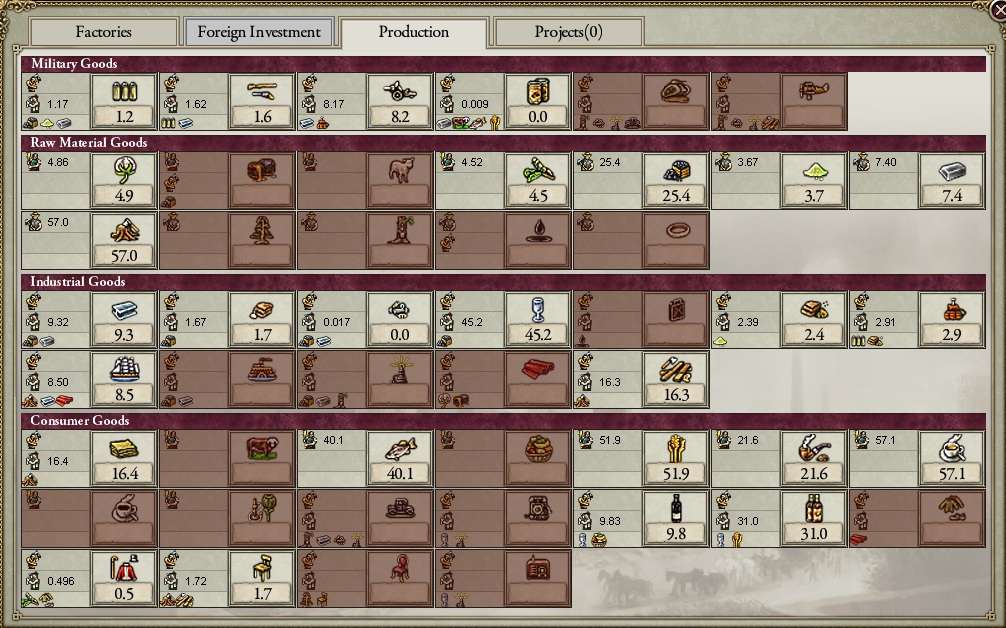 Production screen
Production screen
This screen is relatively uncomplicated. It tells you what you produce (per day), who produces it (whether it's Farmers, Laborers, Artisans, or Craftsman), and, if it's a manufactured good, what the inputs are. Simple enough. (The other tabs won't be relevant until we get factories.)
The last screen we'll visit in detail is the trade screen.
 Trade!
Trade!
How does trade work in AHD? It's (relatively) simple. Let's break it down.
Every thing our loyal POPs produce go into our
domestic market. POPs will
always buy domestic if it's there, so tariffs don't work the way they did in real life (to encourage domestic industries). If you want to find out how much something costs, multiple how many units you need by the global price at that moment. The trade screen gives you a very handy chart down at the bottom of what your people need, market activity (how much you buy in a given day), the size of your stockpile, and the common market. For our purposes, the domestic market and common market are the same thing. What if you don't produce something?
Then, you have to go to the
global market. Access to the global market is based on total score. If we want Wool, for example, we're 68th in line; not a good thing, since we don't produce any. In the top right, you'll see that we can't buy any wool; the 67 jerks in front of us are wool hogs and taking it all.
There's one more possible source for goods: your sphere master/spherelings. If you are in a sphere, you could get access to goods more easily, since your sphere master will give you goods before they'll be released into the global market. That's good. However, if they invest enough money into you (if you're civilized) or if you're uncivilized, they also get 100% of your
domestic market. So if your people need Tea, but America is your boss? Sorry, buddy. America gets the tea first.
Got all that? There's one more item, which changed in later patch versions of vanilla. The government goes to the head of the line. That means that we, the government of Japan, will get our .14 units of wool before our POPs get so much as a strand. This was done primarily to combat shortages of goods like Liquor, which you need for Guards; this does mean that excessive building can make your POPs very unhappy.
The trade screen, as a whole, is normally purely informative. There are two main things you can do: you can manually set how much the government stockpiles of goods, and you can let the unwashed masses into your stockpile (selling goods to POPs). You can very successfully play AHD without doing either of those things; we'll mess with it a little bit in a later update. You could also try to game the global market, if you're so inclined. I'm not that interested in this kind of thing, but it could be done.
We've got two more things to look at. First, our capital's RGO.
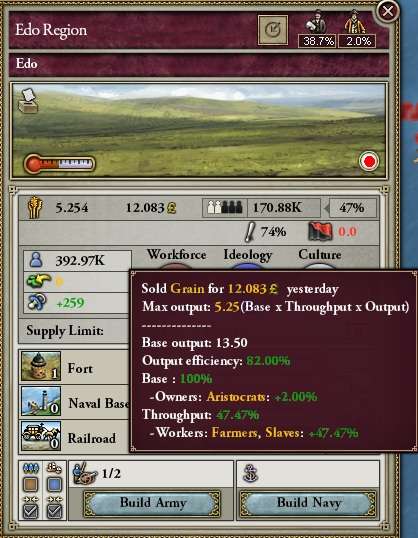 Edo Grain Company, at your service
Edo Grain Company, at your service
RGOs produce all of your raw materials. Edo, as you can see, makes grain. How much grain? Let's break it down.
Base output: This is how much stuff you would make if the RGO was fully employed. It ignores all other modifiers.
Output Efficiency: This is how efficient you are at making stuff. Techs and Aristocrats are your big modifiers here. (I have no idea why it's 80% in this particular example; I've never seen it lower than 100%).
Throughput: Think of this is as how effectively you turn your inputs into outputs. Techs, railroads, and how well employed your workers are affect this.
In our case, it would be 1 x .82 x .4747 (since we're a little less than half employed), or .3892. If we multiply that by the base output, we get 5.25. From the box, that means our math is right. Now, if we multiple that by the world market price (2.38), we get 12.09 £ per day. (The slight difference is probably rounding error.)
We can't do much to improve our RGOs at the juncture. We could use an encourage Farmers NF to try to fill the RGO quicker, but that's about it, at present.
Now, let's see what other goodies are hiding under that RGO box for this province.
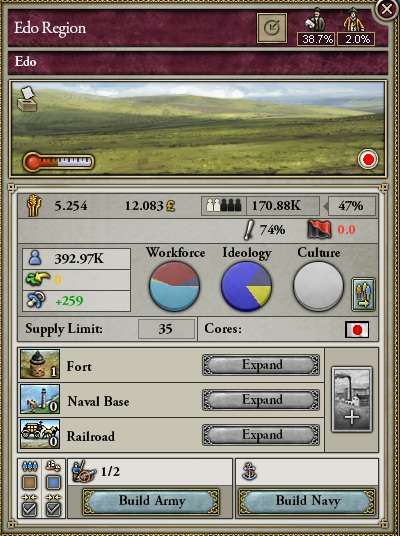 Come out, come out, wherever you are!
Come out, come out, wherever you are!
A lot of this will look familiar; it's information reproduced on a smaller scale. There are a few things I want to point out. One of them is party loyalty, which is new to AHD. Party loyalty means that POPs will keep voting for one particular party unless something makes them do otherwise. Now, it's meaningless at present, but if I were to hover over the little box with the paper in the upper left and we had voting, it would say whether or not the POPs felt loyal to a particular party. Neat, huh?
The other thing I want to highlight here are the rally points in the bottom left; one for armies and one for navies. When a new brigade or ship is built, it will go to the nearest rally point, up to that province's supply limit. Our current supply limit is 35; that means 35 brigades can stand around with no attrition.
There are some other interesting bits on here, including population, immigration, and birthrate (middle left), the size and presence of forts, naval bases, and/or railroads, even a button to build factories here! (If we could.) There is one other thing we ought to talk about now: crime fighting.
On the middle right, you'll see an ! and a Red and Black Flag. The former indicates crime fighting. It's based on the
state administrative efficiency (or how many bureaucrats are in the state) and a generic crime fighting modifier, which is 39.5% if you're fully funding administration. If it's too low, you can have crime in a province. Different criminal groups do different things; if we had any here, it would be to the left of the !. The red and black flag is how riled up this particular province's POPs are, as in how ready they are to revolt.
I've got one more thing to show you: a general map of where we produce our stuff, and what we produce in our RGOs.
 Look at all that tea!
Look at all that tea!
We have a lot of important goods. Tea and Silk will be huge money makers for us, even late into the game, since apparently we don't have Instant Tea in AHD. Coal and Iron will be essentially for when we Westernize. We are missing some useful goods -- Wool is the best example -- but we won't go broke or run out of stuff any time soon.
You know what time it is now? Time to actually play the game some!

March 14, 1836: Gold Rush in Kobe!
 GOOOOOOOOLLLLLLLLLLLLLDDDDDDDDDDDDDDDDD!
GOOOOOOOOLLLLLLLLLLLLLDDDDDDDDDDDDDDDDD!
Precious Metal is a special trade good in Vicky 2. It doesn't actually get traded; instead, it goes right into the Government's pocket. Since we're the government, that's pretty good, isn't it?
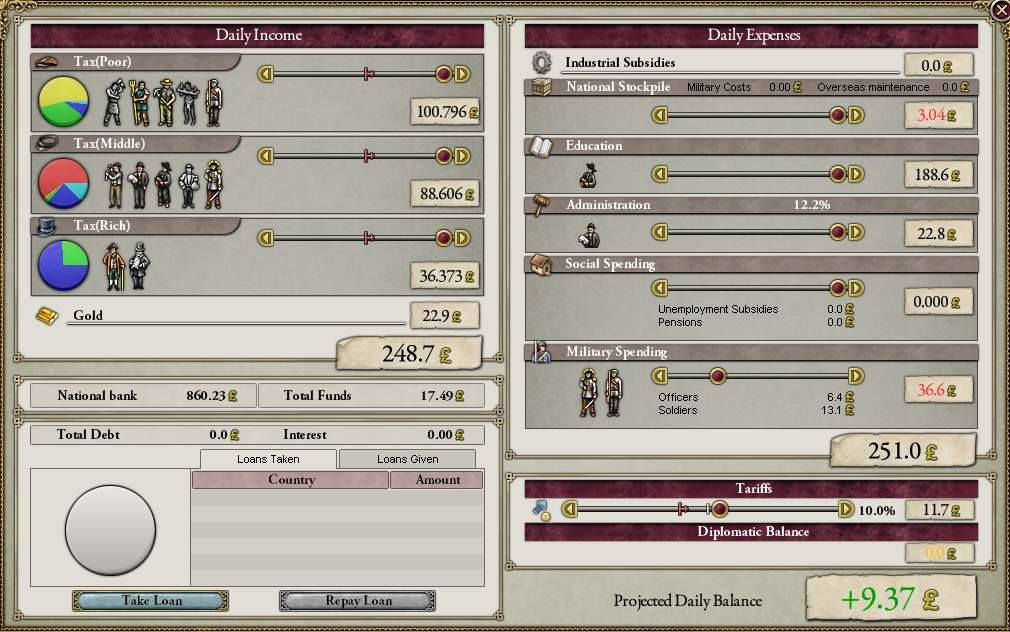 Budget featuring gold
Budget featuring gold
Here's our new budget, now that we have Precious Metal. See how Gold has its own special little category? With our new revenues, we cut tariffs back to 5% (the picture only shows 10%, but I did it cut back to 5%). We're heavily reliant on manufactured goods from outside Japan, so I'd like to get rid of tariffs ASAP.
September 15, 1836: Well, that was a boring six months. You know what would spice things up? A war!
The Casus Belli
Take a look at this screen, from the Justify War menu.
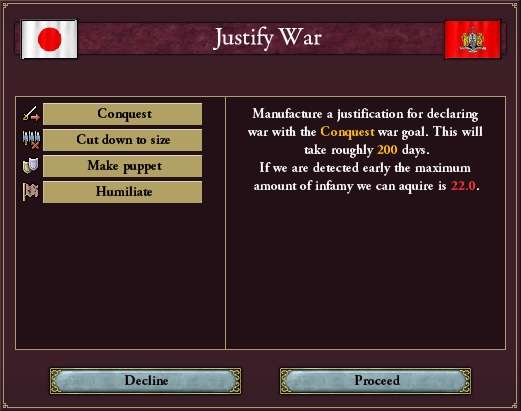 We're coming for you, Zulu!
We're coming for you, Zulu!
As you can see, there are four possible CBs we can choose at present.
Conquest: Zulu becomes part of Japan.
Cut down to size: Zulu pays us 50% of their tax income for five years and cuts their army in half.
Make puppet: Zulu is essentially part of our Sphere of Influence, but they can't leave without a war. Honestly, I've never found it worth it, unless you want control of a country's foreign policy without their resources.
Humiliate: Zulu loses a bunch of Prestige.
Now, which CB you choose depends on two things.
1) How much infamy do you have to spend? Every country has an infamy limit of 25; go over that and every country in the game (unless they're your puppet) can generate a Containment CB.
Readers: The code indicates you still have to justify a war with Containment. Can anybody confirm or deny? Is it still free as it was in vanilla? That's Humiliate + Cut Down to Size. Not the least bit fun.
2) What do you want from the country? If you want resources, Conquest (or Acquire State) is the way to go. If you just want control of their foreign policy, Puppet is fine. Trying to get somebody out of the GP column? Humiliate is the way to go.
Now, CB generation takes time. If you're caught the day you start the justification process, you get hit with the full infamy. If you're never caught, it's zero infamy. Most will be somewhere in between.
I chose Conquest here, because Zulu has Wool and no powerful friends. (Also because I'm a dolt, but we'll see that later.) I also order two Clipper Transports and a Frigate to protect them. Japan starts the game with one Clipper Transport. Clearly, I'll only need 9,000 troops, so this should be fine. Right?
December 6, 1836: A very nice event (and South Park reference).
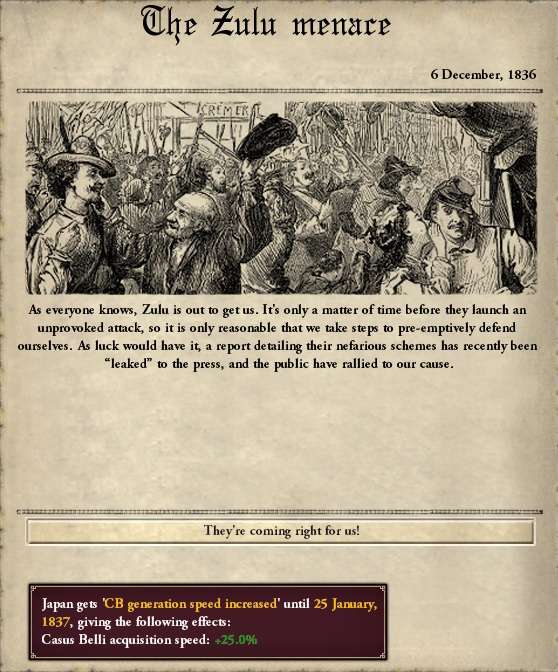
This means our CB will generated faster; that means a quicker CB and, more importantly, less infamy. There are both good.
January 20, 1837: Busted. Zulu learned of our conniving ways.
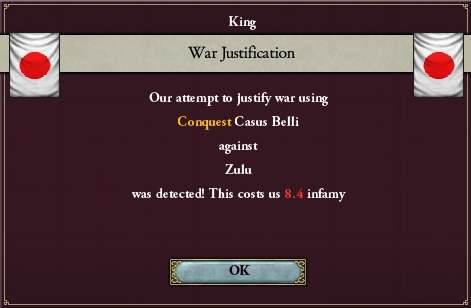
8.4 infamy isn't bad. You generally burn off .1 infamy a month in peace time. It'll be even better when all of those Zulu sheep belong to us!
April 1, 1837: Our CB is done. Huzzah! We have 12 months to use it.
November 23, 1837: I have cleverly placed our mighty fleet right outside Zulu territory. Uh oh. Zulu has 27,000 troops! That's not very good. (Remember; divide by 3000 for the actual number of brigades, in this case 9). Our plan will be to take out the Zulu Army, seize a port, and then hide our fleet there, since we don't have any naval bases. (Yeah, I kind of forgot that part when I was planning this war.)
December 27, 1837: It is time to give Zulu a piece of our mind!
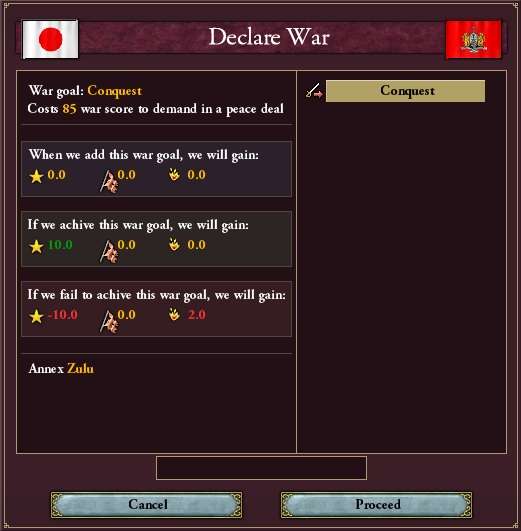
[video=youtube_share;YQkaD6fG8mk]http://youtu.be/YQkaD6fG8mk[/video]
January 22, 1838: Let's take a look at our first actual battle.
Battle
 Gulp.
Gulp.
First, count the number of boxes; you'll see two ranks of thirty on each side, which refers to combat width. Zulu and I have the same techs, so there's no discrepancy. My line is so short that the Zulu can keep two brigades in the back row, where they can't even fight. That's a downer.
Check the modifiers on each side. The Zulu get a -1 for attacking in Hills and -2 because their particular general is terrible at attacking. I get a -2 because I left my only general back in Japan. (Stop snickering!) Add in the fact he got a 9 and I got a 2, and we're even more screwed. Since my die roll adds up to 0, I'll actually inflict no casualties at all this day.
You roll dice at the beginning of each day, and every combat lasts for a minimum of 12 days. See the green bar at the bottom? Oh, right. Mine says zero. That's because we've already lost. The brown bar indicates strength.
After 12 days, you can retreat into any neighboring province, provided they're enemy provinces, your province, an ally's province, or a province you're allowed into via military access. We won't get the chance to retreat.
January 29, 1837: See what I mean?

You'll see that we gained .27 War Exhaustion (the bandaged guy) and lost .72 prestige. At least we inflicted some casualties and gave Zulu a little War Exhaustion. (War Exhaustion can drive up MIL if it gets high enough.) For now, back to the drawing board. I'm going to lose my fleet since I'm way out of Supply Range (the distance from your nearest naval base. Since I don't have any...), so I built six more transports. This time, we'll bring more troops!
May 24, 1838: I add two more transports and a frigate. I'll be able to carry nine brigades this time! (Yes, more than a year passed with nothing happening. Such is the life of the primitive nation.)
December 4, 1838: Our troops load up into our fleet. We shall send along General Yahachi Ugaki. Those Zulu won't know what hit them!
January 28, 1839: We're running low on cash, so I cut Military Spending. That'll mean fewer brigades, but since I don't have very much Wool to build new brigades, that's not a huge deal.
March 22, 1839: We are off to Zulu!
August 12, 1839: We land in Zulu. Now, we have a new problem: Attrition. If you have more troops than the territory can support (the supply limit), you'll take attrition every day (max of 10%, depending on how far over you are) until you get there. I hope the Zulu attack me soon!
August 17, 1839: Battle begins. This time, I have no negative modifiers (my general's stats don't really matter at the moment; we'll discuss general stats in a later update) and even numbers. I also decide to build 12 more brigades of irregulars.
August 25, 1839: That's more like it!
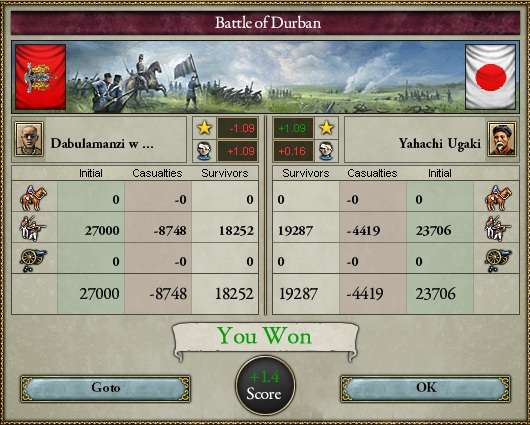
October 12, 1839: Another, even more decisive battle follows. Of course, you know what I forgot? The Zulu can reinforce. I can't. That's a problem. (Why don't I just attack them, you ask? The Zulu General has +2 to defense. He's really being a sport by attacking me so frequently.)
November 22, 1839: Even though I keep inflicting lots of casualties, I'm not recovering ORG very quickly or reinforcing at all. This is the result.
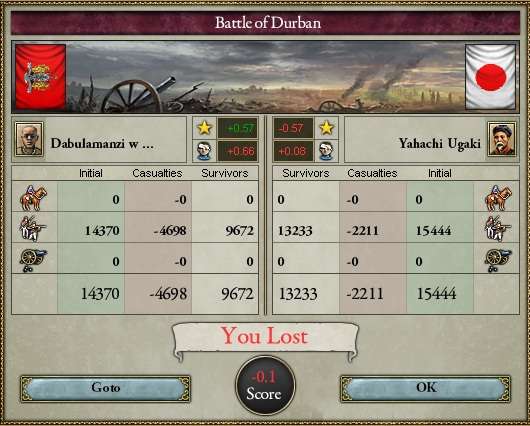
Japanese soldiers run screaming for the boats and survive. That means... it's time for a cunning plan!
January 23, 1840: I went to Ladysmith; now the Zulus have to cross a river AND attack up mountains.
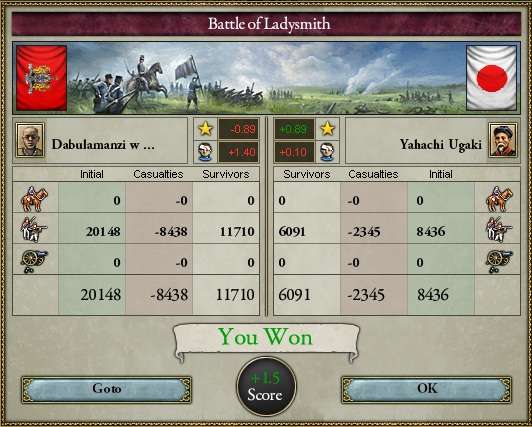
I'm a genius!
February 17, 1840: Or not.
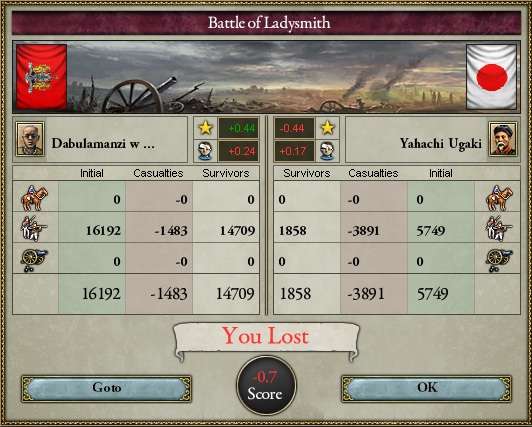
They must have gotten some absurdly lucky dice rolls or something. In any case, this war is over.

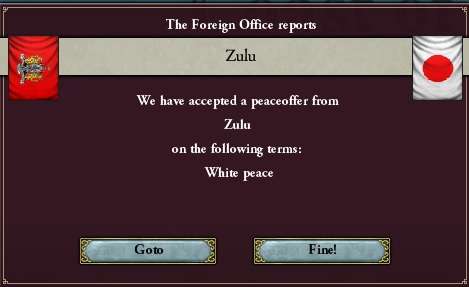
This isn't an EU3 white peace: I'm going to lose prestige and get hit with some MIL. (If you look at the DOW screen, it'll say exactly how much.)
----------------------------------------------------------------------------------------------------------------------------------------
That's enough losing for one update! Is there anything you'd like me to cover I haven't yet? Something I got wrong? Let me know!
)




















